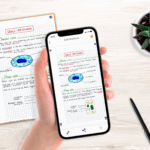
How to personalise your revision notes to boost your visual memory
How to personalise your revision notes to boost your visual memory
Struggling to learn your lessons by heart?
What if your visual memory could be your secret weapon? Discover how to personalise your revision notes to memorise better and revise more effectively – without the stress.
You’ve probably noticed that not everyone remembers information in the same way. Some people learn by re-reading their notes, others by listening, writing things down, or even moving around. That’s because there are different types of memory and figuring out how your brain works can make a huge difference when you’re revising.
So, how do you know if you have a visual memory?
• If you remember where a definition is on a page or which colour you used, you’re probably visual.
• If you remember better by saying your notes out loud, you’re more auditory.
• If you need to write or move around to learn, you’re likely kinesthetic.
Knowing your memory type helps you adapt your revision style. And if you’re a visual learner, customising your revision notes could be the best way to learn faster and remember for longer.
Why visual memory can save you during revision
Before looking at how to personalise your revision notes, here’s a quick recap: visual memory is your ability to remember things through images, colours, diagrams, or even the layout of a page. If you recall a chart or a highlighter colour more easily than a full sentence, you’re already using your visual memory.
Why is this so helpful when revising?
According to cognitive psychology professor Dr Alain Lieury, visual memory is powerful because “we naturally remember images better than words.” This is called the picture superiority effect: your brain holds onto images or colours faster than plain text.
By using your visual memory, you save precious time: your brain makes faster connections between ideas and how they look on your revision card. For example, if you always highlight key dates in yellow and definitions in blue, your brain will instantly link the colour with the information when you need it.
In an exam, your brain “replays” the colours or diagrams that stood out to you, even if you feel like you’ve forgotten. It’s like having a screenshot of your revision notes in your head, ready to pop up when you’re stuck. A quick sketch for photosynthesis or a red box around a maths formula might come back to you much faster than a memorised sentence.
How to turn your revision notes into powerful visual tools
Now that you know how useful your visual memory can be, here are some practical ways to personalise your revision notes.
1. Use colours for different types of information
A colour code makes it easier for your brain to pick out key points:
• Red for definitions
• Green for important dates
• Blue for formulas
• Yellow for must-remember concepts
This system creates “visual anchors” in your memory, which you’ll recall when you need them.
2. Make diagrams or mind maps
Your visual memory loves connections. Instead of listing facts, create diagrams or colourful mind maps to link ideas together. This will make it easier to picture the links when you’re in the exam.
3. Add drawings or symbols
A small sketch or symbol – like a lightbulb for a key idea or a padlock for an essential point – works as an instant marker. Images help your brain connect concepts quickly.
4. Think about your layout
How you set out information matters:
• Avoid big blocks of text – use bullet points.
• Leave white space so your notes don’t look crowded.
• Put the most important info top left or in the middle – that’s where your eyes naturally focus.
By mixing colours, diagrams, symbols, and clear layouts, you’ll turn your notes into visual revision tools that stick in your memory.
Revising with your visual memory using Scribzee
Spent time customising your revision notes with colours, diagrams, and layouts? Keep that same energy in your revision sessions with Scribzee.
When you scan your Oxford revision notes with the Scribzee app, you’ll see them exactly as you made them – colours, titles, sketches, and all. This continuity helps your brain because you’re revising with the same visual cues you created while studying.
If you use Oxford Revision 2.0 revision cards with different coloured frames for different subjects, you can scan and sort them into folders of the same colour in Scribzee. On exam day, your brain will automatically connect the colour to the topic, saving you from digging through piles of notes.
By using Scribzee with your revision notes, you extend the power of your visual memory into your revision sessions – simple and effortless.
In short: if you’ve got a visual memory, lean into it with colours, diagrams, and Scribzee. With personalised revision notes, your revision becomes quicker, clearer, and way more effective.



Your email address will not be published.